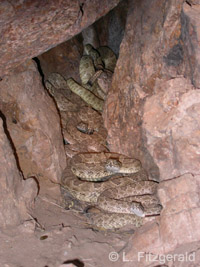
Collaborators: Charles Painter
Rattlesnakes are commercially exploited to supply an international trade in skins, meat,gall bladders, and curios. Five species are used in 8 states: western diamondback rattlesnakes (Crotalus atrox) in Texas, Oklahoma, and New Mexico; eastern diamondback rattlesnakes (C. adamanteus) in Alabama, Florida, and Georgia; prairie rattlesnakes (C. viridis) in Kansas, Texas, Oklahoma, and New Mexico; and timber rattlesnakes (C. horridus) in Pennsylvania, Georgia, Alabama, and Florida. Blacktail rattlesnakes (C. molossus) occasionally appear in the trade in New Mexico and Texas. The trade is linked to rattlesnake, roundups, which are economically important to local communities.

Rattlesnake den
We estimated that 15% of the western diamondback and eastern diamondback rattlesnakes entering the trade originate from roundups. In the 1990s, probably < 125,000 rattlesnakes of all species entered the trade yearly. Analyses of long~term data from 3 rattlesnake roundups showed variable trends in rate of take, number of hunters, and pounds of snakes/hunter. Analysis of the take of western diamondback rattlesnakes from 1959 to 1997 at the roundup at Sweetwater, Texas, showed no long-term trends, but was characterized by extreme variability. Body size (snout-vent length [SVL] and mass) and sex ratios of hunted western diamondback rattlesnakes varied significantly by region and through time. These differences were probably due more to geographic and temporal variation than to the effects of hunting. Rattlesnake harvests of all species were malebiased, and a few hunters collected the majority of the take. A model of the economic impacts of imposing size restrictions on rattlesnake harvests showed that hunters earn 19% more money when restricting take to rattlesnakes >90 cm SVL (size at maturity of most females) whereas profit to the industry increased 6%. Size limits below 90 cm SVL would minimally impact total take; restricting take to rattlesnakes> 90 cm SVL would reduce number of immature females by almost 50%.
Rattlesnake species differ in susceptibility to overexploitation, and research on life-history variation of rattlesnakes should be an important management priority. Information also is needed on local versus regional impacts of hunting, and monitoring information is needed for the entire trade. Rattlesnakes are traded alive, and issues relating to the treatment of live rattlesnakes need to be considered when developing management plans for North American rattlesnakes.
